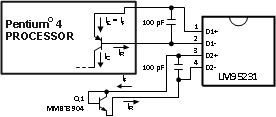SNIS139F February 2005 – January 2024 LM95231
PRODUCTION DATA
- 1
- 1 Features
- 2 Applications
- 3 Description
- 4 Pin Configuration and Functions
- 5 Specifications
- 6 Detailed Description
-
7 Registers
- 7.1 LM95231 Registers
- 7.2 Status Register
- 7.3 Configuration Register
- 7.4 Remote Diode Filter Control Register
- 7.5 Remote Diode Model Type Select Register
- 7.6 Remote TruTherm Mode Control
- 7.7 Local and Remote MSB and LSB Temperature Registers
- 7.8 Manufacturers ID Register
- 7.9 Die Revision Code Register
- 8 Application and Implementation
- 9 Layout
- 10Device and Documentation Support
- 11Revision History
- 12Mechanical, Packaging, and Orderable Information
Package Options
Mechanical Data (Package|Pins)
- DGK|8
Thermal pad, mechanical data (Package|Pins)
Orderable Information
8.2.1.1 Diode Non-Ideality Factor Effect on Accuracy
When a transistor is connected as a diode, the following relationship holds for variables VBE, T and IF:

where

- q = 1.6×10−19 Coulombs (the electron charge),
- T = Absolute Temperature in Kelvin
- k = 1.38×10−23joules/K (Boltzmann's constant),
- η is the non-ideality factor of the process the diode is manufactured on,
- IS = Saturation Current and is process dependent,
- If= Forward Current through the base emitter junction
- VBE = Base Emitter Voltage drop
In the active region, the -1 term is negligible and may be eliminated, yielding the following equation

In Equation 2, η and IS are dependant upon the process that was used in the fabrication of the particular diode. By forcing two currents with a very controlled ratio (IF2/IF1) and measuring the resulting voltage difference, it is possible to eliminate the IS term. Solving for the forward voltage difference yields the relationship:

Solving Equation 3 for temperature yields:

Equation 4 holds true when a diode connected transistor such as the MMBT3904 is used. When this “diode” equation is applied to an integrated diode such as a processor transistor with its collector tied to GND as shown in Figure 8-1 it will yield a wide non-ideality spread. This wide non-ideality spread is not due to true process variation but due to the fact that Equation 4 is an approximation.
TruTherm technology uses the transistor equation, Equation 5, which is a more accurate representation of the topology of the thermal diode found in an FPGA or processor.

 Figure 8-1 Thermal Diode Current Paths
Figure 8-1 Thermal Diode Current PathsTruTherm should only be enabled when measuring the temperature of a transistor integrated as shown in the processor of Figure 8-1, because Equation 5 only applies to this topology.